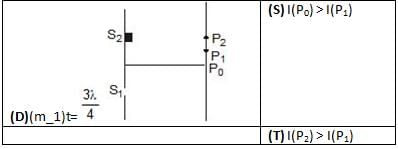NEET Previous Year Questions: Waves - 2 - NEET MCQ
13 Questions MCQ Test - NEET Previous Year Questions: Waves - 2
In the ideal souble-slit experiment, when a glass - plate (refractive index 1.5) of thickness t is introduced in the path of one of the interfering beams (wavelength l), the intensity at the position where the central maximum occurred previously remains unchanged. The minimum thickness of the glass-plote is :
[JEE 2002]
In the adjacent diagram, CP represents a wavefront and AO and BP, the corresponding two rays. Find the condition on q for constructive interference at P between the ray BP and
reflected ray OP.
[JEE (Scr)2003]
A prism (mP =  ) has an angle of prism A = 30°. A thin film (mf = 2.2) is coated on face AC as shown in the figure. Light of wavelength 550 nm is incident on the face AB at 60° angle of incidence. Find
) has an angle of prism A = 30°. A thin film (mf = 2.2) is coated on face AC as shown in the figure. Light of wavelength 550 nm is incident on the face AB at 60° angle of incidence. Find
(i) the angle of its emergence from the face AC and
(ii) the minimum thickness (in nm) of the film for which
the emerging light is of maximum possible intensity.
(ii) the minimum thickness (in nm) of the film for which
In a YDSE bi-chromatic light of wavelengths 400 nm and 560 nm are used. The distance between the slits is 0.1 nm and the distance between the plane of the slits and the screen is 1m. The minimum distance between two successive regions of complete darkness is -
[JEE' 2004 (Scr)]
In a Young's double slit experiment, two wavelengths of 500 nm and 700 nm were used. What is the minimum distance from the central maximum where their maximas coincide again ? Take D/d = 103. Symbols have their usual meanings.
[JEE 2004]
In Young's double slit experiment maximum intensity is I than the angular position where the intensity becomes 1/4 is -
[JEE' 2005 (Scr)]
The figure shows a surface XY separating two transparent media, medium-1 and medium-2. The lines ab and cd represent wavefronts of a light wave traveling in medium-1 and incident on XY. The lines ef and gh represent wavefronts of the light wave in medium-2 after refraction.
[JEE 2007]
Light travels as a -
The phases of the light wave at c, d, e and f are fc, fd, fe and ff respectively. It is given that fc ¹ ff .
[JEE 2007]
In a Young's double slit experiment, the separation between the two slits is d and the wavelength of the light is l. The intensity of light falling on slit 1 is four times the intensity of light falling on slit 2. Choose the correct choice(s).
[JEE 2008]
Column I shows four situations of standard Young's double slit arrangement with the screen placed far away from the slits S1 and S2 . In each of these cases S1P0 = S2 P0 , S1 P1 _ S2 P1 = l / 4 and S1P2 _ S2 P2 = l/3, where l is the wavelength of the light used. In the casesB,C and D, a transparent sheet of refractive index m and thickness t is pasted on slit S2 . The thicknesses of the sheets are different in different cases. The phase difference between the light waves reaching a point P on the screen from the two slits is denoted by d(P) and the intensity by I(P). Match each situation given in Column I with the statement(s) in Column II valid for that situation. [JEE 2009]




Young's double slit experiment is carried out by using green, red and bluelight, one color at a time. The fringe widths recorded are bG, bR and bb, respectively. Then.
[JEE 20012]
In the young's double slit experiment using a monochromatic light of wavelength l, the path difference (in terms of an integer n) corresponding to any point having half the peak intensity is :
[JEE 2013]















